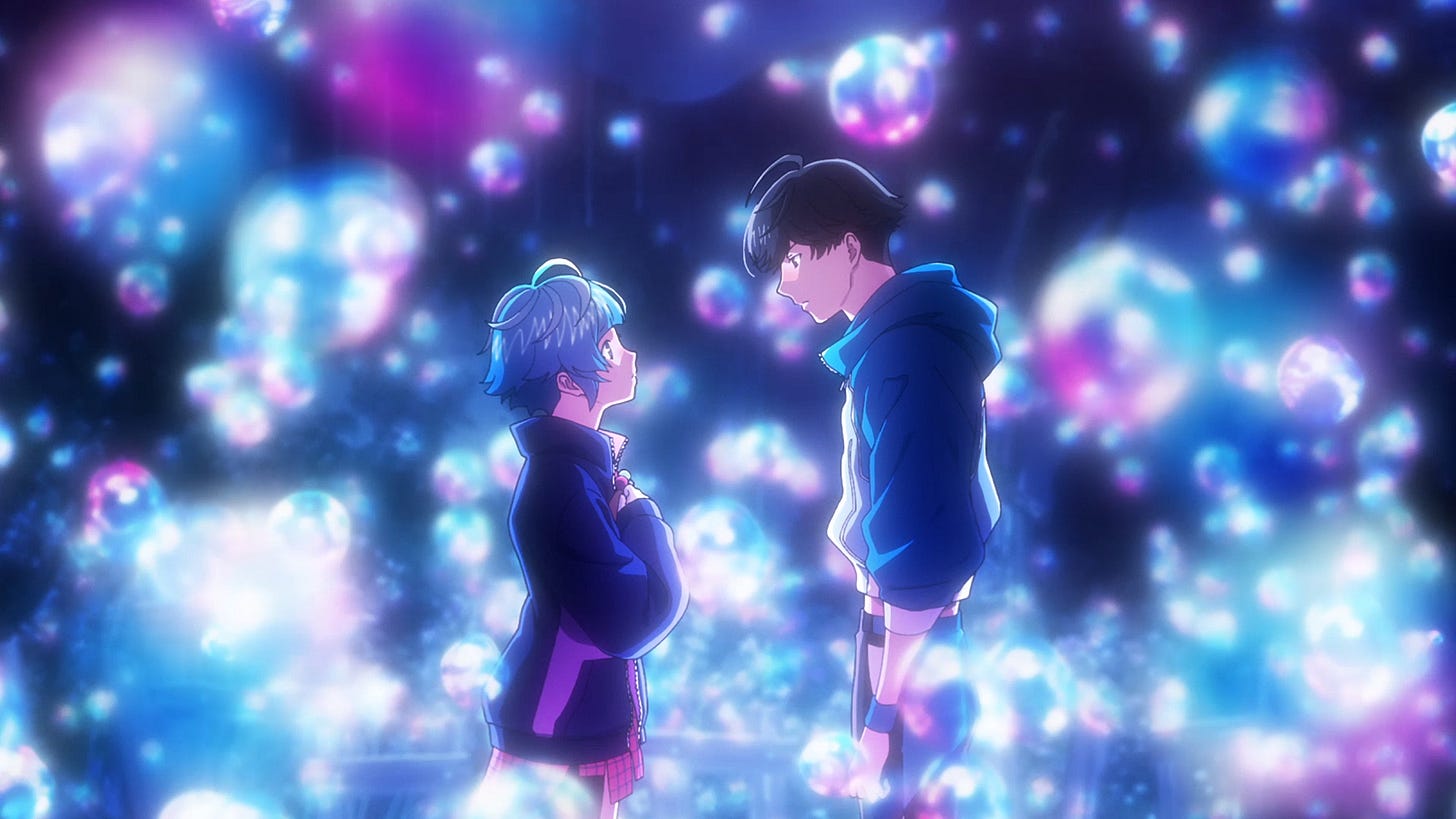Bubble
From the gorgeous animation to the well done score, "Bubble" is a flawed yet delightful film that you can't help but be mesmerized by.
Film Yap is a reader-supported publication. To receive new posts and support my work, consider becoming a free or paid subscriber.
Anime films are certainly hitting a nerve much more consistently than they were a decade ago. From great niche films getting a limited run treatment in theaters to anime features even making enough money during a pandemic to rival a studio release, it’s clear that Japanese animated films are growing in popularity as time passes. With that in mind, it’s no surprise that Netflix (who has been trying to up their anime catalog fairly consistently each year) would get their hands on the original anime film “Bubble”: the latest feature film from Wit Studio, the studio most notably known for the first three seasons of the incredibly popular anime “Attack on Titan”. With an incredibly stacked creative team behind the film, it was no surprise that Netflix has been building anticipation for the film since December of last year. Now that it’s finally here, how does “Bubble” fare?
The film takes place in a Tokyo that has been ravaged by strange bubbles, causing explosions, mass flooding, and even changes in gravity. Five years after the bubbles appeared, the film follows Hibiki (Jun Shison), a quiet but talented orphan that competes in parkour matches (a 5-on-5 game called "battlekour") to earn resources as well as respect from other orphans who still live in the destroyed city. As a survivor of the explosion that decimated the Tokyo Tower, he's constantly pulled to the wreckage in hopes of discovering what the tune stuck in his head comes from. While trying to find answers, he ends up getting thrown into the water. Before he could drown, a mysterious girl (Riria) saves his life.
In response to saving his life, Hibiki brings the girl to his battlekour team's headquarters, leading them all to slowly teach the girl about the world. After becoming more acclimated with the team, Hibiki gives her the name "Uta" as well as noticing some romantic feelings towards her. With no information as to where she's from, where did she come from? Is she connected to the bubble phenomenon? And why is she the only one that knows the tune stuck in Hibiki's head?
While the film's plot is surprisingly more straightforward as it gets going, it's no surprise that the main pull of the film is its gorgeous animation. There's such a vivid color palette that never gets boring. From Uta's colorful outfit to even the crisp blues in the sky, it's a film that is certainly putting massive effort into making a film that sticks with you visually even if the narrative doesn't. With character designs from Takeshi Obata (most known for his work on "Death Note"), every character stands out even with the little amount of development they have. Mix in the inspirations from the classic "The Little Mermaid" tale by Hans Christian Andersen and you have probably one of the prettiest films that's come out so far this year.
On top of the beautiful animation, the action and the score compliment the film very well. With the seasoned “Attack on Titan” director Tetsurô Araki at the helm, the film’s freerunning/parkour action sequences are fluid, exciting, and incredibly dynamic. The climax in particular has a sequence where the animation team definitely took their years of animating aerial action scenes in “Attack on Titan” to create one of the most satisfying sequences in the film. The action is wild, fun, and pairs very well with Hiroyuki Sawano’s score. From the slow, beautiful moments to the heart-pounding action sequences, Sawano does a great job of capturing the intended emotions of the scene and amplifying them at the right time.
Despite all of the positives “Bubble” brings to the table, the film does have one glaring issue: its story. While the narrative runs pretty smoothly after an expository scene in the first act, what’s left in the film is a story that is pretty bare bones overall. The arcs of the characters (both main and supporting) are pretty thin, the film’s pacing takes a bit of a halt in the second act, and its third act certainly brings some interesting elements to the table but ultimately leaves too many questions unanswered. While the finale certainly resonated with me emotionally far more than I expected, the narrative ultimately becomes more of a hassle than it has any right to be. For a film that wears its main inspiration on its sleeve, it tends to take a bit too long to get to the twists and turns many will be able to see from a mile away.
Regardless of my issues with the narrative, it’s still nice to see an original anime feature getting the exposure very few would’ve gotten a decade prior. From the gorgeous animation to the well done score, “Bubble” is an anime film that’ll linger a bit longer than anticipated. While the film is certainly not perfect, I’m glad Netflix is supporting the film by giving it a bigger audience than it probably would’ve gotten as a limited theater run in the United States. With hype surrounding the film due to the talented team behind it, I’m happy to report that the film is flawed but worth a watch. In the end, “Bubble” is a delightful film that’ll no doubt charm anyone willing to give the film a try.



